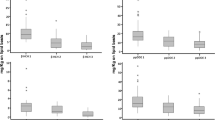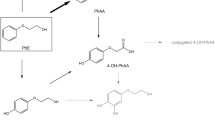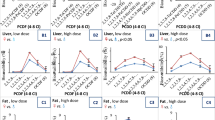Abstract
To evaluate skin lipid analysis for the accumulation level of environmental pollutants, the correlations between organochlorine pesticide residues in adipose tissue, blood, and skin lipids of monkeys were studied. The mixture of β-hexachlorocyclohexane (β-HCH), p,p′-DDT, and trans-chlordane was subcutaneously given to monkeys once weekly for 5 weeks at dose levels of 1 and 10 mg/kg. The chemicals distributed in adipose tissue, blood, and skin lipids were determined six times after the last dosing at intervals of 4 to 9 weeks.
Oxychlordane and p,p′-DDE were detected in all tissues together with the administered chemicals. In blood and adipose tissue, trans-chlordane decreased rapidly and oxychlordane and p,p′-DDE increased gradually and then remained at constant levels. β-HCH and p,p′-DDT in adipose tissue increased until the 12th week and then decreased in all animals. The correlation coefficients between blood and adipose tissue regardless of dose level and collection time for each chemical ranged from 0.83 to 0.94. Correlation coefficients between skin lipids and adipose tissue varied with the chemical, namely, 0.31, 0.72, 0.81, 0.81, and 0.83 for p,p′-DDE, tras-chlordane, p,p′-DDT, β-HCH, and oxychlordane, respectively. The results indicated that skin lipid analysis may be useful for the evaluation of specific pollutants in the body burden.
Similar content being viewed by others
References
Barnett JR, Dorough HW (1974) Metabolism of chlordane in rats. J Agric Food Chem 22:612–619
Curley A, Garrettson LK (1969) Acute chlordane poisoning. Clinical and chemical studies. Arch Environ Health 18:211–215
Durham WF, Ortega P, Hayes WJ (1963) The effect of various dietary levels of DDT on liver function, cell morphology, and DDT storage in the rhesus monkey. Arch Intern Pharmacodyn Ther 141:111–129
Miyazaki T, Yamagishi T, Matsumoto M (1986) Component patterns of chlordanes in human milk, cow's milk, dog adipose tissue, cat adipose tissue and wild bird. J Food Hyg Soc Japan 27:481–486
Nicolaides N (1974) Skin lipids: Their biochemical uniqueness. Science 186:19–26
Nishimaki-Mogami T, Minegishi K, Takahashi A, Kawasaki Y, Kurokawa Y, Uchiyama M (1988) Characterization of skinsurface lipids from the monkey (Macaca fascicularis). Lipids 23:869–877
Sasaki K, Ishizaka T, Suzuki T, Takeda M, Uchiyama M (1991) Organochlorine chemicals in skin lipids as an index of their accumulation in the human body. Arch Environ Contam Toxicol 21:190–194
Steinwandter H (1982) Silica gel application in pesticide-residue analysis. Fresenius Z Anal Chem 312:342–345
Street JC, Blau SE (1972) Oxychlordane: Accumulation in rat adipose tissue of feeding chlordane isomers or technical chlordane. J Agric Food Chem 20:395–397
Wariishi M, Nishiyama K (1989) Observations on the progress of chlordane contamination in humans by blood and sebum analysis. Arch Environ Contam Toxicol 18:501–507
Wolff MS (1984) Analysis of skin lipids for halogenated hydrocarbons. Anal Chem 56:1492–1496
Yamagishi T, Kaneko S, Miyazaki T, Akiyama K, Horii S (1981) Oxychlordane, trans-nonachlor and cis-nonachlor residues in adipose tissues of dogs and cats collected in the Tokyo area. Bull Environ Contam Toxicol 26:407–412
Author information
Authors and Affiliations
Rights and permissions
About this article
Cite this article
Sasaki, K., Kawasaki, Y., Sekita, K. et al. Disposition of β-hexachlorocyclohexane, p,p′-DDT, and trans-chlordane administered subcutaneously to monkeys (Macaca fascicularis). Arch. Environ. Contam. Toxicol. 22, 25–29 (1992). https://doi.org/10.1007/BF00213298
Received:
Revised:
Issue Date:
DOI: https://doi.org/10.1007/BF00213298




